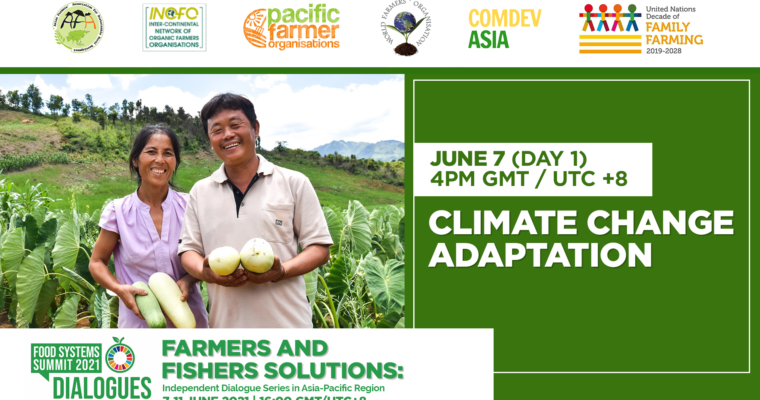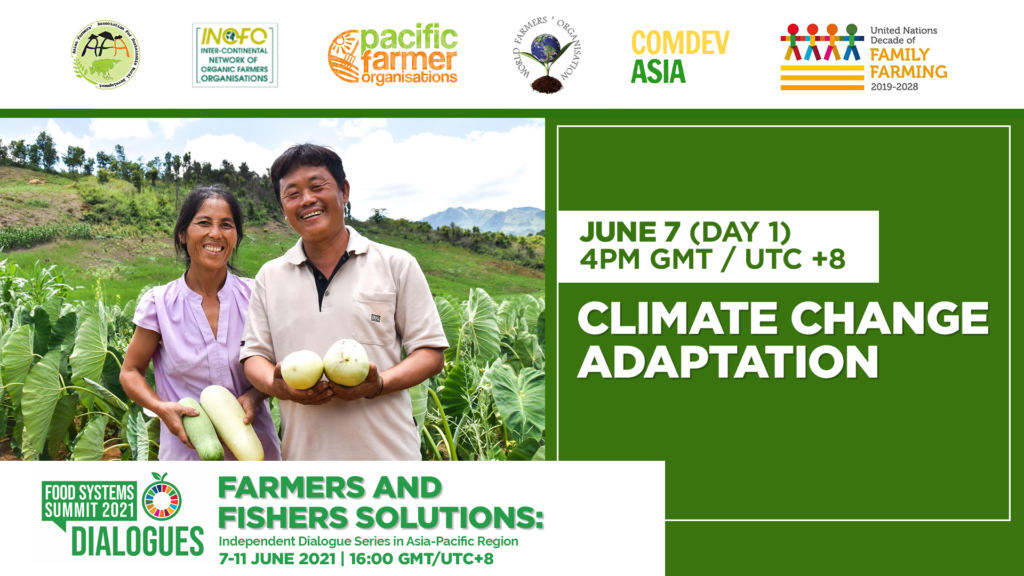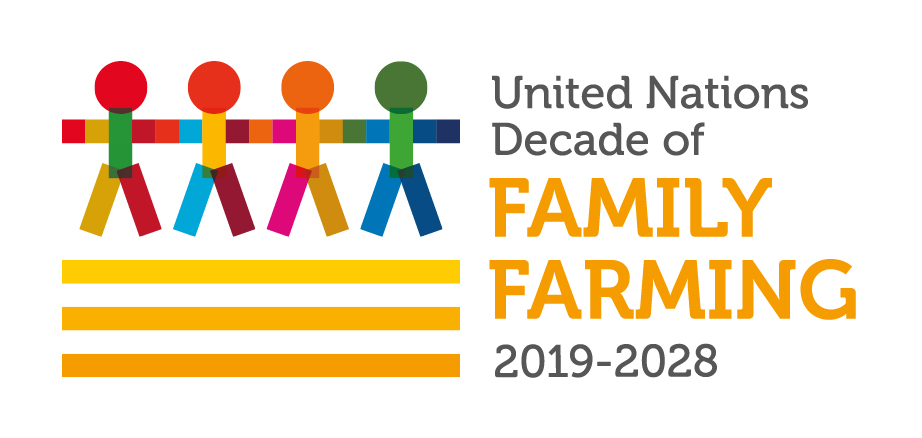Sustainable Food Systems and Climate Change Adaption
Organized by the Pacific Island Farmers Organisation Network (PIFON)
June 7, 2021, 4:00 PM – 6:30 PM Philippine Standard Time
Understanding the Food Systems Summit
The UN Secretary-General, António Guterres, has called on all world leaders to take part in the Food Systems Summit in 2021 to help establish the future direction for food systems in the world and accelerate collective action to that end. This reflects the recognition that transforming food systems is central in efforts to achieve all the 17 Sustainable Development Goals (SDGs) by 2030. The Summit will be held in New York in September 2021 and will be preceded by a Pre-Summit in Rome in July 2021.
The Food Systems Summit will launch new actions to deliver progress on all 17 SDGs, each of which relies to some degree on healthier, more sustainable, and equitable food systems.
The Summit expects the following outcomes:
- Dramatically elevated public discourse about the importance of food systems leading to the achievement of the SDGs.
- Significant action, with measurable outcomes. (This will include highlighting existing solutions and celebrating leaders in food systems transformation, as well as calling for new actions worldwide)
- A high-level set of principles established through the process that will guide the Member States and other stakeholders to leverage their food systems capacity to support the SDGs.
- A system of follow-up and review that will drive new actions and results; allow for sharing of experiences, lessons, and knowledge; and incorporate new metrics for impact analysis.
However, debates are surfacing as to what direction the food systems summit will take to ensure that issues on hunger, malnutrition, social justice, and the planet will be at the fore of these solutions. A revisit and evaluation of our present food system is also imperative if we are to chart a transformative, just, resilient, and sustainable food system that puts the interests and needs of food producers and consumers across the globe. As such, they said summit matters to everyone, from the food producers to the consumers, and has never been timelier given the challenges of the Covid 19 pandemic.
Food Systems Summit Dialogues
In preparation for the Summit, the UN Special Envoy for the Food Systems Summit Dr. Agnes Kalibata has invited all sectors of society to share their perspectives and solutions. These Dialogues obtain input from a global audience (from youth activists to indigenous leaders, from smallholder farmers to scientists and CEOs) both before and after the Summit with the aim to transform the way the world produces, consumes, and disposes of food.
Independent Summit Dialogues, such as this event facilitated by Farmers Forum, will only connect to the Summit process through an official feedback mechanism. Independent Summit Dialogues will offer opportunities and spaces for citizens to critically engage and propose pathways towards sustainable food systems, exploring new ways of working together and encouraging collaborative action.
The outcomes of the Dialogues will feed into the Summit’s five priority Action Tracks and the preparatory work of its Scientific Group to support changes in global food systems to deliver the SDGs by 2030.
Independent Dialogues on Climate Change Adaptation
[1]Agriculture has supported Asia Pacific communities for thousands of years, but in recent years, population growth, deforestation and the intensification of crop production for commercial purposes has threatened the very foundation of agriculture: the soil. Soil condition and fertility vary considerably across countries, with more fertile and productive soils found in volcanic lands and islands. The loss of soil fertility threatens the productivity of crops, and soil erosion through run-off into the sea is damaging the coral reefs on which island communities largely depend for their protein.
Jon Barnett (2011) summed up the potential impact of climate change: ‘Climate change will adversely affect food systems in the region, including the supply of food from agriculture and fisheries, the ability of countries to import food, systems for the distribution of food, and the ability of households to purchase and utilize food. In these ways, climate change puts at risk the very basic and universal need for people in the islands to have access to sufficient, safe, and nutritious food at all times’
Agricultural products are a significant component of exports for many countries in the region and food production activities (agriculture and fishing) continue to employ the greatest percentage of the labour force, either in commercial enterprises, or more commonly, in self-sufficiency endeavors. This is despite the Asia Pacific region comprising the most environmentally vulnerable nations in the world. Natural disasters, such as cyclones, floods, and droughts are not new to the region. However, the climate projections for the 21st century and beyond, suggest that extreme events such as heatwaves, droughts, tsunamis, typhoons, and floods are likely to increase in frequency and intensity, projected rainfall and rainfall patterns are likely to create problems for a region already affected by droughts and floods, and cyclones, typhoons are most likely to increase in intensity. Extreme high tides and storm surges will probably continue to threaten low-lying flat lands and islands, as will the ongoing sea-level rise, which will cause contamination of groundwater.
It is vital therefore that the Asia Pacific region assesses the vulnerability of its agriculture sector so that strategies can be developed both to cope with extreme climate events and improve the resilience of production systems to the changing climate.
Vulnerability to climate change has different dimensions as the focus turns from plants, trees, and animals through agricultural systems and landscapes, to individuals, households, communities, and countries. Individual plants, trees and animals have vulnerabilities to changes in climate, which can be assessed by considering their physiological thresholds or limits within different emission scenarios. The vulnerability of agricultural systems can be modified by changing practices, such as altering planting dates, changing the mix of varieties or species, introducing innovative systems, or reviving traditional practices weaved in with modern-day sciences.
Women tend not to have access to the key information and education critical for adapting to a rapidly changing climate (McOmber et al. 2013). This is due to many factors linked to tradition (in the Pacific) and work burdens. At best, this reduces their potential to contribute to the household, community, and national responses, and at worst their vulnerability to extreme weather events is increased. It is crucial that women are fully involved in the development of climate change adaptation strategies and in capacity building related to climate change, as it is women who tend to remain behind to run farms and gardens when men move away to seek employment in urban areas.
Understanding the gendered division of labour within Asia Pacific communities can assist in providing a more in-depth understanding of community perspectives on changes to climate and the environment. It can also provide a useful entry point for harnessing specialized knowledge in developing strategies for adapting to climate change. Adaptation solutions must build on the diverse knowledge, priorities and capacities of both women and men. Further, promoting equitable access to adaptation knowledge for women and men is a key practical step for inclusive adaptation.
Agriculture and food security are closely linked and therefore the impact of climate change on agriculture has significant consequences for food security. Traditional farming systems, have provided resilience against external shocks and helped to maintain food security (McGregor et al. 2008). Today threats to food security have intensified with the move away from the more resilient agro-ecosystems of the past, and with increasing population and urbanisation. The projections for climate change add a further threat, by increasing the vulnerability of food production systems both within the region and beyond.[i]
Objectives of the Independent Dialogue
- Inform and educate the participants about the issues and challenges of the present food system and how adaptation of climate change innovation systems in addressing these issues
- Make use of the Independent Dialogue to put the voices of the small farmers and the marginalized in setting the agenda and proposing pro-farmer, pro-people and pro-planet solutions to the Food Systems Summit
Program
Moderator: Angela Birch
| Time | Topic | Speaker/Person-in-Charge |
| 3:30 – 4:00 PM | Admission of Participants in Zoom Conference (Slide show of Panel Bio’s, opening prayer & Ice Breaker) | Irish Dominado, AFA
|
| 4:00 – 4:05 PM | Welcome Message (5 minutes) | Kyle Stice, PIFON |
| 4:05 – 4:30 PM | Food Systems Summit Overview | Esther Penunia, AFA Secretary General |
| 4:31 – 4:40 PM | The Role of Farmer Organisations in Climate Change Adaptation | Lavinia Kaumaitotoya
PIFON |
| 4:41 – 4:50 PM | Key Issue – “Climate Change Pacific” Video | PIFON Technical Support |
| 4:51 – 5:10 PM
(4:51 -5:00 PM)
(5:00 – 5:10 PM) | Strategies to help farmers adapt to Climate Change
Improving capacities of Farmer Organisations to manage Pests & Diseases
Cover crops and soil management |
Jiu Daunivalu CEO, Fiji Crop & Livestock Council
INOFO |
| 5:11 – 6:45
(5:11 – 5:20 PM)
(5:21 – 5:30 PM) | Farmer Organisations initiatives to help farmers adapt to climate change
Rainfall Insurance
Crop disaster management and variety selection programs |
SEWA
PIFON |
| 5:31 – 6:10 PM
(40 mins) | Breakout sessions: Sub-regional discussions on recommendations
1. Aside from what has been presented, what are other initiatives, innovative solutions to the barriers and challenges would you recommend to the UNFSS? 2. Are there specific strategies or innovation that have successfully address climate change related challenges of women and young farmers? 3. Please enumerate ways for scaling out and scaling up implementation of the solutions, initiatives (e.g. policy intervention, program development, investments, intervention from the financial institutions) |
Moderators and documentors will be assigned for each sub regional break out group: Southeast Asia, South Asia, East/Central Asia Pacific |
| 6:11 – 6:25 PM | Plenary: Report to main group | Nominated representatives |
| 6:25 – 6:30 PM | Closing remarks | Lavinia Kaumaitotoya
Manager PIFON |
[1] Vulnerability Pacific Island Agriculture Forestry Climate Change (Taylor,McGregor,Dawson 2016)
[i][i] Vulnerability Pacific Island Agriculture Forestry Climate Change (Taylor, McGregor, Dawson 2016)





Comments are closed